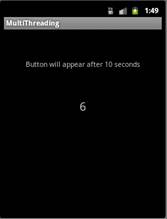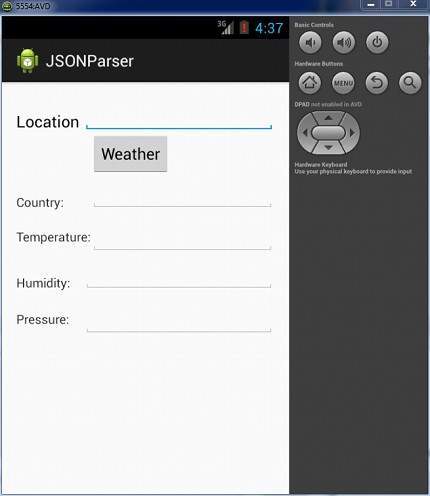Main Activity:
package com.example.mymap;
import java.util.ArrayList;
import java.util.HashMap;
import android.content.Intent;
import android.os.Bundle;
import android.support.v4.app.FragmentActivity;
import android.view.View;
import android.widget.AdapterView;
import android.widget.AdapterView.OnItemClickListener;
import android.widget.ListAdapter;
import android.widget.ListView;
import android.widget.SimpleAdapter;
public class MainActivity extends FragmentActivity {
ArrayList<HashMap<String, String>> dataList = new ArrayList<HashMap<String,String>>();
ListView list;
@Override
protected void onCreate(Bundle savedInstanceState) {
super.onCreate(savedInstanceState);
setContentView(R.layout.activity_main);
list=(ListView)findViewById(R.id.listView1);
HashMap<String, String> map=new HashMap<String, String>();
map.put("cityName", "XYZ");
map.put("lat", "17.363848900000000000");
map.put("longi", "78.534850699999990000");
dataList.add(map);
HashMap<String, String> map1=new HashMap<String, String>();
map1.put("cityName", "YXZ");
map1.put("lat", "17.374445000000000000");
map1.put("longi", "78.505896000000000000");
dataList.add(map1);
HashMap<String, String> map2=new HashMap<String, String>();
map2.put("cityName", "ZXY");
map2.put("lat", "17.382042000000000000");
map2.put("longi", "78.481727299999990000");
dataList.add(map2);
ListAdapter adapter = new SimpleAdapter(
MainActivity.this, dataList,
R.layout.mycustom_layout, new String[] { "cityName", "lat",
"longi" }, new int[] { R.id.name,
R.id.email, R.id.mobile });
list.setAdapter(adapter);
list.setOnItemClickListener(new OnItemClickListener() {
@Override
public void onItemClick(AdapterView<?> parent, View view,
final int position, long id) {
HashMap<String, String> map2= dataList.get(position);
String city=map2.get("cityName");
String lat=map2.get("lat");
String longo=map2.get("longi");
// Starting single contact activity
Intent in = new Intent(getApplicationContext(), SingleContactActivity.class);
in.putExtra("cityName", city);
in.putExtra("lat", lat);
in.putExtra("longi", longo);
startActivity(in);
}
});
}
}
SingleContactActivity:
package com.example.mymap;
import android.content.Intent;
import android.os.Bundle;
import android.support.v4.app.FragmentActivity;
import android.util.Log;
import android.view.View;
import android.view.View.OnClickListener;
import android.widget.ArrayAdapter;
import android.widget.Button;
import android.widget.Spinner;
import android.widget.Toast;
import com.google.android.gms.common.ConnectionResult;
import com.google.android.gms.common.GooglePlayServicesUtil;
import com.google.android.gms.maps.CameraUpdate;
import com.google.android.gms.maps.CameraUpdateFactory;
import com.google.android.gms.maps.GoogleMap;
import com.google.android.gms.maps.GoogleMap.OnInfoWindowClickListener;
import com.google.android.gms.maps.SupportMapFragment;
import com.google.android.gms.maps.model.BitmapDescriptorFactory;
import com.google.android.gms.maps.model.LatLng;
import com.google.android.gms.maps.model.Marker;
import com.google.android.gms.maps.model.MarkerOptions;
public class SingleContactActivity extends FragmentActivity{
@Override
protected void onCreate(Bundle savedInstanceState) {
super.onCreate(savedInstanceState);
setContentView(R.layout.activity_map);
// getting intent data
Intent in = getIntent();
// Get JSON values from previous intent
String name = in.getStringExtra("cityName");
// Receiving latitude from MainActivity screen
double latitude = getIntent().getDoubleExtra("lat", 0);
// Receiving longitude from MainActivity screen
double longitude = getIntent().getDoubleExtra("longi", 0);
LatLng position = new LatLng(latitude, longitude);
// Instantiating MarkerOptions class
// Getting Reference to SupportMapFragment of activity_map.xml
SupportMapFragment fm = (SupportMapFragment)getSupportFragmentManager().findFragmentById(R.id.map);
// Getting reference to google map
GoogleMap googleMap = fm.getMap();
MarkerOptions options = new MarkerOptions();
// Setting position for the MarkerOptions
options.position(position);
// Setting title for the MarkerOptions
options.title(name);
// Setting snippet for the MarkerOptions
options.snippet("Latitude:"+latitude+",Longitude:"+longitude);
// Adding Marker on the Google Map
googleMap.addMarker(options);
// Creating CameraUpdate object for position
CameraUpdate updatePosition = CameraUpdateFactory.newLatLng(position);
// Creating CameraUpdate object for zoom
CameraUpdate updateZoom = CameraUpdateFactory.zoomBy(4);
// Updating the camera position to the user input latitude and longitude
googleMap.moveCamera(updatePosition);
// Applying zoom to the marker position
googleMap.animateCamera(updateZoom);
}
}
package com.example.mymap;
import java.util.ArrayList;
import java.util.HashMap;
import android.content.Intent;
import android.os.Bundle;
import android.support.v4.app.FragmentActivity;
import android.view.View;
import android.widget.AdapterView;
import android.widget.AdapterView.OnItemClickListener;
import android.widget.ListAdapter;
import android.widget.ListView;
import android.widget.SimpleAdapter;
public class MainActivity extends FragmentActivity {
ArrayList<HashMap<String, String>> dataList = new ArrayList<HashMap<String,String>>();
ListView list;
@Override
protected void onCreate(Bundle savedInstanceState) {
super.onCreate(savedInstanceState);
setContentView(R.layout.activity_main);
list=(ListView)findViewById(R.id.listView1);
HashMap<String, String> map=new HashMap<String, String>();
map.put("cityName", "XYZ");
map.put("lat", "17.363848900000000000");
map.put("longi", "78.534850699999990000");
dataList.add(map);
HashMap<String, String> map1=new HashMap<String, String>();
map1.put("cityName", "YXZ");
map1.put("lat", "17.374445000000000000");
map1.put("longi", "78.505896000000000000");
dataList.add(map1);
HashMap<String, String> map2=new HashMap<String, String>();
map2.put("cityName", "ZXY");
map2.put("lat", "17.382042000000000000");
map2.put("longi", "78.481727299999990000");
dataList.add(map2);
ListAdapter adapter = new SimpleAdapter(
MainActivity.this, dataList,
R.layout.mycustom_layout, new String[] { "cityName", "lat",
"longi" }, new int[] { R.id.name,
R.id.email, R.id.mobile });
list.setAdapter(adapter);
list.setOnItemClickListener(new OnItemClickListener() {
@Override
public void onItemClick(AdapterView<?> parent, View view,
final int position, long id) {
HashMap<String, String> map2= dataList.get(position);
String city=map2.get("cityName");
String lat=map2.get("lat");
String longo=map2.get("longi");
// Starting single contact activity
Intent in = new Intent(getApplicationContext(), SingleContactActivity.class);
in.putExtra("cityName", city);
in.putExtra("lat", lat);
in.putExtra("longi", longo);
startActivity(in);
}
});
}
}
SingleContactActivity:
package com.example.mymap;
import android.content.Intent;
import android.os.Bundle;
import android.support.v4.app.FragmentActivity;
import android.util.Log;
import android.view.View;
import android.view.View.OnClickListener;
import android.widget.ArrayAdapter;
import android.widget.Button;
import android.widget.Spinner;
import android.widget.Toast;
import com.google.android.gms.common.ConnectionResult;
import com.google.android.gms.common.GooglePlayServicesUtil;
import com.google.android.gms.maps.CameraUpdate;
import com.google.android.gms.maps.CameraUpdateFactory;
import com.google.android.gms.maps.GoogleMap;
import com.google.android.gms.maps.GoogleMap.OnInfoWindowClickListener;
import com.google.android.gms.maps.SupportMapFragment;
import com.google.android.gms.maps.model.BitmapDescriptorFactory;
import com.google.android.gms.maps.model.LatLng;
import com.google.android.gms.maps.model.Marker;
import com.google.android.gms.maps.model.MarkerOptions;
public class SingleContactActivity extends FragmentActivity{
@Override
protected void onCreate(Bundle savedInstanceState) {
super.onCreate(savedInstanceState);
setContentView(R.layout.activity_map);
// getting intent data
Intent in = getIntent();
// Get JSON values from previous intent
String name = in.getStringExtra("cityName");
// Receiving latitude from MainActivity screen
double latitude = getIntent().getDoubleExtra("lat", 0);
// Receiving longitude from MainActivity screen
double longitude = getIntent().getDoubleExtra("longi", 0);
LatLng position = new LatLng(latitude, longitude);
// Instantiating MarkerOptions class
// Getting Reference to SupportMapFragment of activity_map.xml
SupportMapFragment fm = (SupportMapFragment)getSupportFragmentManager().findFragmentById(R.id.map);
// Getting reference to google map
GoogleMap googleMap = fm.getMap();
MarkerOptions options = new MarkerOptions();
// Setting position for the MarkerOptions
options.position(position);
// Setting title for the MarkerOptions
options.title(name);
// Setting snippet for the MarkerOptions
options.snippet("Latitude:"+latitude+",Longitude:"+longitude);
// Adding Marker on the Google Map
googleMap.addMarker(options);
// Creating CameraUpdate object for position
CameraUpdate updatePosition = CameraUpdateFactory.newLatLng(position);
// Creating CameraUpdate object for zoom
CameraUpdate updateZoom = CameraUpdateFactory.zoomBy(4);
// Updating the camera position to the user input latitude and longitude
googleMap.moveCamera(updatePosition);
// Applying zoom to the marker position
googleMap.animateCamera(updateZoom);
}
}
activity_main:
<RelativeLayout xmlns:android="http://schemas.android.com/apk/res/android"
xmlns:tools="http://schemas.android.com/tools"
android:layout_width="match_parent"
android:layout_height="match_parent"
tools:context="${relativePackage}.${activityClass}" >
<ListView
android:id="@+id/listView1"
android:layout_width="match_parent"
android:layout_height="wrap_content"
/>
</RelativeLayout>
activity_map:
<?xml version="1.0" encoding="utf-8"?>
<LinearLayout xmlns:android="http://schemas.android.com/apk/res/android"
xmlns:tools="http://schemas.android.com/tools"
android:layout_width="match_parent"
android:layout_height="match_parent"
android:orientation="vertical" >
<TextView
android:id="@+id/textView1"
android:layout_width="wrap_content"
android:layout_height="wrap_content"
android:text="Google Places" />
<fragment
android:id="@+id/map"
android:name="com.google.android.gms.maps.SupportMapFragment"
android:layout_width="match_parent"
android:layout_height="match_parent" />
</LinearLayout>
custom_layout
<?xml version="1.0" encoding="utf-8"?>
<LinearLayout xmlns:android="http://schemas.android.com/apk/res/android"
android:layout_width="fill_parent"
android:layout_height="wrap_content"
android:orientation="vertical"
android:padding="10dp"
android:paddingLeft="10dp"
android:paddingRight="10dp" >
<!-- Name Label -->
<TextView
android:id="@+id/name"
android:layout_width="fill_parent"
android:layout_height="wrap_content"
android:paddingBottom="2dip"
android:paddingTop="6dip"
android:textColor="#43bd00"
android:textSize="16sp"
android:textStyle="bold" />
<!-- Email label -->
<TextView
android:id="@+id/email"
android:layout_width="fill_parent"
android:layout_height="wrap_content"
android:paddingBottom="2dip"
android:textColor="#acacac" />
<!-- Mobile number label -->
<TextView
android:id="@+id/mobile"
android:layout_width="wrap_content"
android:layout_height="wrap_content"
android:gravity="left"
android:text="Mobile: "
android:textColor="#5d5d5d"
android:textStyle="bold" />
</LinearLayout>
Manifest file:
<?xml version="1.0" encoding="utf-8"?>
<manifest xmlns:android="http://schemas.android.com/apk/res/android"
package="com.example.mymap"
android:versionCode="1"
android:versionName="1.0" >
<uses-sdk
android:minSdkVersion="8"
android:targetSdkVersion="19" />
<uses-permission android:name="android.permission.INTERNET" />
<permission
android:name="com.example.mymap.permission.MAPS_RECEIVE"
android:protectionLevel="signature" />
<uses-permission android:name="com.example.mymap.permission.MAPS_RECEIVE" />
<uses-permission android:name="android.permission.ACCESS_NETWORK_STATE" />
<uses-permission android:name="android.permission.WRITE_EXTERNAL_STORAGE" />
<uses-permission android:name="com.google.android.providers.gsf.permission.READ_GSERVICES" />
<uses-permission android:name="android.permission.ACCESS_COARSE_LOCATION" />
<uses-permission android:name="android.permission.ACCESS_FINE_LOCATION" />
<uses-feature
android:glEsVersion="0x00020000"
android:required="true" />
<application
android:allowBackup="true"
android:icon="@drawable/ic_launcher"
android:label="@string/app_name"
android:theme="@style/AppTheme" >
<meta-data
android:name="com.google.android.maps.v2.API_KEY"
android:value="Here Your Google Map Key" />
<meta-data
android:name="com.google.android.gms.version"
android:value="@integer/google_play_services_version" />
<activity
android:name=".MainActivity"
android:label="@string/app_name" >
<intent-filter>
<action android:name="android.intent.action.MAIN" />
<category android:name="android.intent.category.LAUNCHER" />
</intent-filter>
</activity>
<activity
android:name="com.example.mymap.SingleContactActivity"
android:label="@string/app_name" >
</activity>
</application>
</manifest>



